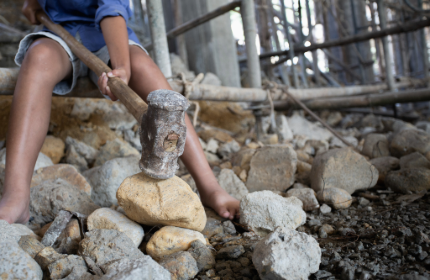At-risk children’s ‘broken’ NSW government protection system is harming them, advocates say – ABC News
After more than 20 years as a child protection case worker, Betina Huber reached her breaking point last year.
“Seeing the children’s pain and suffering on a day-to-day basis it got to a point where I thought ‘I can’t do it anymore’,” she said.
After a period of leave, Ms Huber resigned in February.
She had worked for the New South Wales government’s Department of Communities and Justice (DCJ), overseeing the care of children removed from family homes for their own welfare.
Ms Huber said that while it could be difficult to hear and see what was happening to children in their own homes, she felt the welfare system was also “abusive” to them.
The NSW government last week revealed that more than 400 children in NSW were being put in hotels, motels, and caravan parks, supervised by a rotating roster of staff in “high-cost emergency care” arrangements.
“If you could just imagine what it would be like for your three or your five-year-old to be looked after by constantly changing adults you have no relationship with,” Ms Huber said.
“Their behaviour changes after a couple of months. They start acting out. They’re scared and distressed, and it’s just awful.”
The government is conducting an “urgent” six-month review to find solutions and alternatives to the current emergency care arrangements.
The case of Ray
In 2022, six-year-old Ray was removed from his parents and taken into care for the second time in his life.
He was placed with a third-party agency, which in turn placed him into emergency care arrangements where he lived in a serviced apartment with a roster of workers.
In a decision handed down last month, NSW Children’s Magistrate Nicole Ford said Ray — who was given a pseudonym by the court — had a “particularly distressing experience”.
“On my analysis of the evidence, he has had in excess of 100 adults acting as caregiver to him,” Magistrate Ford said.
After a period of being separated, the agency placed Ray and his three siblings in one household in October 2023, where more than 10 people provided care to them.
Magistrate Ford said there was “nothing appropriate” about the arrangement, but rather that it was “damaging and causing harm”.
DCJ retains legal responsibility for children in care in NSW, even after they are placed with an agency.
Magistrate Ford said that, while in care, Ray had his appendix removed “infested by worms”, lost weight, and had dental work left untreated.
“I am troubled on so many aspects about the children’s circumstances,” she said.
“[I] have formed the view the [DCJ] secretary has not only failed to protect the children from harm but has caused harm to the children.”
Vulnerable children overlooked
While the welfare of children who are in the care of the state is of concern, evidence suggests there are many more vulnerable children who are not being seen at all.
Figures from DCJ show that last year, 113,688 children in NSW were considered at risk of significant harm.
Less than a quarter of them were seen by a DCJ case worker.
The district encompassing Northern NSW, Mid North Coast, and New England performed the worst, with only 15 per cent of at-risk children being seen.
“It means that the parents are not getting the help, and it means the children are not getting the help,” Ms Huber said.
“And it means that it’s more likely they will be removed and end up in the dysfunctional out-of-home care system. It just is devastating to see.”
|
Districts |
Children at risk of significant harm |
Children seen |
Percentage |
|---|---|---|---|
|
Central Coast, Hunter |
18,321 |
3,191 |
17pc |
|
Far West, Murrumbidgee, Western NSW |
15,950 |
3,532 |
22pc |
|
Illawarra Shoalhaven, Southern NSW |
8,908 |
2,006 |
23pc |
|
Mid North Coast, New England, Northern NSW |
18,582 |
2,707 |
15pc |
|
Nepean Blue Mountains, Western Sydney |
17,775 |
4,164 |
23pc |
|
South Western Sydney |
14,786 |
2,809 |
19pc |
|
Sydney, Northern Sydney, South Eastern Sydney |
14,072 |
3,136 |
22pc |
|
Other (across NSW) |
5,294 |
4,354 |
82pc |
|
TOTAL: |
113,688 |
25,899 |
23pc |
Source: DCJ Caseworker Public Dashboard
Vacancies and burnout
Some 11 per cent of DCJ case worker positions were vacant in October-December last year.
The Public Service Association said the vacancy rate was as high as 25 per cent in northern NSW, with reports of burnout and a high staff turnover.
It is campaigning for an extra 500 case workers to be employed.
Union delegate Nin Bennett said that would also help caseworkers engage in more early intervention work, to help the children who are slipping through the cracks.
“It would mean that the visits with the children become meaningful, we can actually do the work that we’re employed to do, and we can actually work towards better outcomes,” she said.
“Without that, I think people are going to continue to let go and walk away, which only means that those outcomes don’t change for children.”
NSW Families and Communities Minister Kate Washington said she recognised the need to support case workers.
“There is a very real consequence for the caseworker vacancies that are in the system at the moment on children and young people who are risk of significant harm, so we are working as hard as we can to ensure that the vacancies in the system are filled,” she said.
“We need to attract more caseworkers and retain the caseworkers in the system, and to do that we must make sure they feel valued, because they have not felt valued for years.”
But Ms Huber also called for an overhaul of the “onerous” paperwork and processes.
“It becomes really stressful when you wait for approval for a financial plan or a placement, and you just don’t hear back from senior management.”
Frustrated carers relinquishing children
The NSW government says one solution to the damaging emergency care arrangements is to recruit more foster carers.
But it is struggling to retain the ones it already has.
Courtney, whose real name has been withheld for privacy, has taken about 10 children into her home as a foster carer over the past decade.
“Generally, you’ll get a phone call and children will arrive within an hour or a few hours. It’s very quick,” she said.
“They usually come with a small file or a piece of paper, if you’re lucky, just taking little snippets about their needs or perhaps a plan, if they’ve been in care previously … and then the rest is up to you to try and work it out.”
Courtney has provided emergency, respite, short-term, and long-term care.
But unless it is a long-term placement, carers are often unable to access funding or plans for specialists such as paediatricians and speech therapists.
Courtney said short-term placements could last a year.
“The frustration of not being able to get our kids the best, in a faster time frame, and watch them struggle and set them up badly, it’s hard. It’s hard work.”
She said it had forced some foster carers to give up.
“I do know of families who had to say goodbye to little ones because they were not supported enough,” Courtney said.
“They had to relinquish care to make a point that the child needs more than what is being given.”
Courtney added her voice to the chorus of calls for an overhaul of the child protection.
“People at the top don’t change anything,” she said.
“I don’t think they truly know how broken it is, and how our children and families are just suffering, and it’s not getting any better, at all.”
Do you have information to share on this story? Send us an email.
Posted 6 May 20246 May 2024Mon 6 May 2024 at 9:32pm, updated 6 May 20246 May 2024Mon 6 May 2024 at 10:34pm


